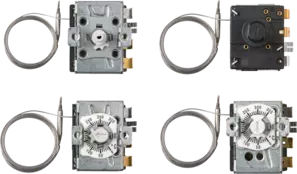
JUMO heatTHERM P300
- Max. switching capacity 30 A, 480 V
- Max. capillary length 5000 mm
- Max. control range up to 365 °C

























Temperature switches are designed for controlling and monitoring temperatures in various systems and applications. They switch an electrical contact when the temperature exceeds or falls below a certain level, thereby preventing overheating or ensuring sufficient heating.
A very precise control result is achieved with temperature controllers. These measure the temperature with a temperature sensor and, as PID controllers, they regulate the temperature exactly to the setpoint value. In the case of binary control, precise adjustment is possible by changing the relative switch-on time of the actuator. For example, the heat output can be varied from 0 to 10 kW.
In contrast, temperature switches are assigned to the discontinuous two-state controllers – the process temperature fluctuates with them around the setpoint value. In many applications, such temperature fluctuations are acceptable, so that temperature switches can be used to set up very robust temperature control at low cost.
What is the difference between a temperature switch and a temperature controller? – JUMO-FAQ
As the name suggests, a bimetal is used in bimetal switches. The 2 metals that are rolled onto each other (e.g. copper and nickel) have different expansion coefficients. As the temperature rises, the metals expand to different degrees so that a deflection occurs and a contact is opened (NC) or closed (NO).
Bimetal switches in industrial environments have a very compact design and are usually screwed into the process like a sensor. Their switching point is fixed during production. They are also very resistant to vibration – a vibration resistance of up to 10 g is not uncommon. The switches are connected in the direction of the evaluation system via a connection line. Temperature switches with a bimetal are used in such devices as compressors – they switch off the compressor in the event of excess temperature or start active cooling (e.g. fan).
This type of temperature switch is usually referred to as a thermostat and consists of a probe filled with a gas or liquid that is placed in the process. If the temperature at the probe rises, the system pressure increases. Because the membrane is connected to the sensor via the capillary line, the same pressure is created in it. The membrane expands and a snap-action switch is triggered. The inner diameter of the capillary line with 0.2 mm is just twice the diameter of a human hair (up to 0.1 mm).
The probe and the thermostat housing are connected to each other via the capillary line. Maximum capillary line lengths of up to 5 m can be regarded as practical. The switching point can usually be set on the housing.
How do gas or liquid-filled temperature switches work? – JUMO-FAQ